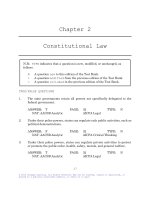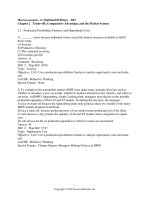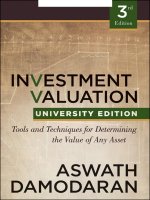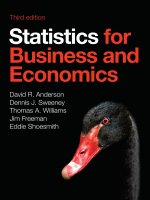Modern principles macroeconomics 3rd by cowen tabbarrok
Bạn đang xem bản rút gọn của tài liệu. Xem và tải ngay bản đầy đủ của tài liệu tại đây (33.52 MB, 570 trang )
THIRD EDITION
W
Dear Student:
Cowen • Tabarrok
e love economics.We talk economics, argue economics, and think about economics every day.We use economics
in our lives, not just when we choose whether to refinance a mortgage but also when we choose strategies for dating,
keeping a good marriage, and parenting. Yeah, we are weird. But now a warning. If you are afraid of being a little weird,
Do Not Read This Book. Once you have been exposed to the economic way of thinking, there is no going back—you will
see the world differently and that will make you different.
Will what you learn be worth the price? That is for you to decide. But we think economics is important. We need
economics to make better investments and better life choices. Citizens in a democracy must evaluate issues of taxes, deficits,
trade, health care policy, and inflation. These issues and many more cannot be understood without an understanding of
economics. Do you want to vote ignorantly or intelligently? The economic way of thinking will help you to understand
the issues of the day and to explain them with confidence to others.
We won’t lie: economics can be difficult. Few things worth knowing come easily and, to understand economics well,
you will need to master new tools and new ideas like supply and demand curves, marginal thinking, and equilibrium. We
have worked hard, however, to strip away as much jargon and unnecessary verbiage as possible. We are going to give you
what is important and not much else. We are also going to have fun. In addition, be sure to check out the new videos that
can help you with the course content and enhance your fun.
MODERN PRINCIPLES:
MACROECONOMICS
Welcome to the world of economics.
1
LaunchPad makes preparing for class and studying for exams more
effective. Everything you need is right here in one convenient
location—a complete interactive e-Book, all interactive study
tools, and several ways to assess your understanding of concepts.
Alex Tabarrok
This game-like quizzing system helps you focus your study time
where it’s needed most. Quizzes adapt to correct and incorrect
answers and provide instant feedback and a learning path unique
to your needs, including individualized follow-up quizzes that help
build skills in areas that need more work.
OVER 90%
LearningCurve is
BENEFICIAL
LaunchPad and LearningCurve Build Success!
LaunchPad is even more efficient when used with LearningCurve. In
fact, students overwhelmingly recommend its use to their friends and
peers. Would you? Contact us at to
share your impressions….
Integrated Online Resources
New Work It Out online tutorials guide students through the process
of applying economic analysis and math skills to solve the final
problem in each chapter.
SCAN here for a sample Work It Out problem
of students said
LearningCurve’s tools
and support helped them
manage their study time
and get better grades.
95%
LearningCurve is
of students would
recommend LearningCurve
to another student.
APPROVED
by students
LearningCurve helped students...
Prepare better for class
95%
Improve knowledge
of course material
MODERN PRINCIPLES:
Tyler Cowen
MACROECONOMICS
LaunchPad logo suite
Recommend LearningCurve
to other students
Earn better grades
0
25
50
75
100
Percentage of students
Strongly agree
Agree
Somewhat agree
New Videos
Pioneers in teaching economics online, the authors have created a
series of videos that are clever, to the point, and will help you better
understand key economic concepts. The video links are included in
the book along with QR codes for mobile access.
THIRD
EDITION
/>SCAN Here for a sample Video
/>@worthecon
facebook.com/ModernPrinciples
WORTH
WORTH
PUBLISHERS
Tyler Cowen • Alex Tabarrok
www.macmillanhighered.com
Cover images: Earth: Jim Roof/myLoupe.com; Hands: © Oleh Barabash / Alamy.
this page left intentionally blank
C O W E N
•
TAB ARROK
MODERN PRINCIPLES: MACROECONOMICS, THIRD EDITION
The compelling examples enhance the
story and illuminate concepts...
means chapter opening example;
means running example in the chapter.
CHAPTER OPENING
RUNNING EXAMPLE
Chapter 1: The Big Ideas
Page 1 CHAPTER OPENING : A small change in wording has
a big effect on the incentives of captains transporting
convicts to Australia.
Page 3: How can drugs be too safe?
Chapter 2: The Power of Trade and
Comparative Advantage
Page 21: Economics is about cooperation, not just
competition
Chapter 3: Supply and Demand
Page 29 CHAPTER OPENING and RUNNING EXAMPLE : Intuitive
picture of the demand for oil and why it slopes
downward
Page 36: Intuitive picture of the supply of oil and why it
slopes upward.
Chapter 4: Equilibrium: How Supply and Demand
Determine Prices
Page 47 CHAPTER OPENING and RUNNING EXAMPLE : What
pushes and pulls prices toward their equilibrium values?
Page 49: Why does a free market maximize consumer plus
producer surplus?
Chapter 5: Price Ceilings and Floors
Page 67 CHAPTER OPENING and RUNNING EXAMPLE : Why did
Nixon’s price controls lead to shortages and lines?
Page 77: How do rent controls work: and fail?
Chapter 6: GDP and the Measurement
of Progress
Page 109: GDP does not count leisure
Page 110: Why does GDP not count environmental costs?
Chapter 7: The Wealth of Nations and
Economic Growth
Page 126: Economic growth: South Korea versus North
Korea
Page 132: Why do landlocked countries have lower per
capita GDP?
Chapter 8: Growth, Capital Accumulation, and
the Economics of Ideas (Solow Model)
Page 146: Why bombing a country can raise its
growth rate
Page 159: How do spillovers dampen the generation of
new ideas?
Chapter 9: Saving, Investment, and the
Financial System
Page 192: Why was leverage a chief cause of the financial
crisis?
Page 195: How did shadow banking contribute to the
financial crisis?
Chapter 10: Stock Markets and Personal Finance
Page 218: Can speculative bubbles be identified?
Chapter 11: Unemployment and Labor
Force Participation
Page 239: Percent job losses in post-1945 recessions.
Page 243: How did the pill help increase female labor
force participation?
Chapter 12: Inflation and the Quantity Theory
of Money
Page 249: Why did money growth lead to hyperinflation
in Zimbabwe?
Page 264: Why is inflation painful to stop?
Chapter 13: Business Fluctuations:
Aggregate Demand and Supply
Page 280: Real shocks and the weather in India
Page 292: Aggregate demand shocks and real shocks in
the Great Depression
Chapter 14: Transmission and
Amplification Mechanisms
Page 304: Labor adjustment costs
Page 308: Collateral damage
Chapter 15: The Federal Reserve System and
Open Market Operations
Page 325: The Fed, short run interest rates, and the
Federal Funds rate
Page 328: The Fed and systemic risk
S E E T H E I N V I S I B L E H A N D . C O M
KEY:
C O W E N
•
TAB ARROK
MODERN PRINCIPLES: MACROECONOMICS, THIRD EDITION
S E E T H E I N V I S I B L E H A N D . C O M
Chapter 16: Monetary Policy
Chapter 19: International Trade
Page 351: Can the Fed deal with asset price bubbles?
Page 352: Rules versus discretion: What about a nominal
GDP rule?
Page 413: What is the cost of the sugar tariff?
Page 418: How does trade affect child labor?
Chapter 17: The Federal Budget:
Taxes and Spending
Page 376: Is government spending wasted?
Page 380: Will the U.S. government go bankrupt?
Chapter 18: Fiscal Policy
Page 401: Why did fiscal policy make matters worse
in Argentina?
Page 402: When is fiscal policy a good idea?
Chapter 20: International Finance
Page 428: Thinking about the U.S. trade deficit and your
trade deficit
Chapter 21: Political Economy and Public Choice
Page 455: How do special interests such as U.S. sugar
growers push for favorable legislation?
Page 462: Democracies and the mean voter theorem
Page 465: Democracies and famine
MODERN PRINCIPLES:
MACROECONOMICS
this page left intentionally blank
MODERN PRINCIPLES:
MACROECONOMICS
Third Edition
Tyler Cowen
George Mason University
Alex Tabarrok
George Mason University
Vice President, Editorial: Charles Linsmeier
Vice President, Editing, Design, and Media Production: Catherine Woods
Executive Editor: Carlise Stembridge
Marketing Manager: Tom Digiano
Consulting Editor: Paul Shensa
Senior Developmental Editor: Bruce Kaplan
Supplements and Media Editor: Lindsay Neff
Art Director: Diana Blume
Cover and Text Designer: Diana Blume
Director of Editing, Design, and Media Production: Tracey Kuehn
Managing Editor: Lisa Kinne
Project Editor: Fred Dahl, TSIevolve
Photo Editor: Robin Fadool
Production Manager: Barbara Anne Seixas
Supplements Production Manager: Stacey Alexander
Supplements Project Editor: Edgar Doolan
Composition: TSIevolve
Printing and Binding: RR Donnelley
Cover Image: © Oleh Barabash/Alamy and Jim Roof/myLoupe.com
Library of Congress Preassigned Control Number: 2014952564
ISBN-13: 978-1-4292-7840-9
ISBN-10: 1-4292-7840-4
© 2015, 2013, 2010 by Worth Publishers
All rights reserved.
Printed in the United States of America
First printing
Worth Publishers
41 Madison Avenue
New York, NY 10010
www.worthpublishers.com
Economics is the study of how to get the most out of life.
Tyler and Alex
this page left intentionally blank
ALEX TABARROK
ABOUT THE AUTHORS
Tyler Cowen (left, in North Korea) is Holbert C. Harris Professor of
Economics at George Mason University. His latest book is The Great Stagnation.
With Alex Tabarrok, he writes an economics blog at MarginalRevolution.com.
He has published in the American Economic Review, Journal of Political Economy,
and many other economics journals. He also writes regularly for the popular
press, including the New York Times, the Washington Post, Forbes, the Wilson
Quarterly, Money Magazine, and many other outlets.
Alex Tabarrok (right, in South Korea) is Bartley J. Madden Chair in Economics
at the Mercatus Center at George Mason University. His latest book is Launching
the Innovation Renaissance. His research looks at bounty hunters, judicial incentives and elections, crime control, patent reform, methods to increase the supply
of human organs for transplant, and the regulation of pharmaceuticals. He is the
editor of the books Entrepreneurial Economics: Bright Ideas from the Dismal Science
and The Voluntary City: Choice, Community, and Civil Society, among others.
His papers have appeared in the Journal of Law and Economics, Public Choice,
Economic Inquiry, the Journal of Health Economics, the Journal of Theoretical Politics,
the American Law and Economics Review, and many others. Popular articles have
appeared in the New York Times, the Wall Street Journal, Forbes, and many other
magazines and newspapers.
ix
this page left intentionally blank
BRIEF CONTENTS
Preface............................................................................................................ xxiii
CHAPTER 1 The Big Ideas................................................................................ 1
CHAPTER 2 The Power of Trade and Comparative Advantage..................... 13
Part I: Supply and Demand
CHAPTER 3 Supply and Demand................................................................... 27
CHAPTER 4 Equilibrium: How Supply and Demand Determine Prices.......... 47
CHAPTER 5 Price Ceilings and Floors............................................................ 67
Part 2: Economic Growth
CHAPTER 6 GDP and the Measurement of Progress..................................... 95
CHAPTER 7 The Wealth of Nations and Economic Growth......................... 117
CHAPTER 8 Growth, Capital Accumulation, and the Economics of Ideas:
Catching Up vs. the Cutting Edge............................................................... 143
CHAPTER 9 Saving, Investment, and the Financial System.......................... 175
CHAPTER 10 Stock Markets and Personal Finance...................................... 207
Part 3: Business Fluctuations
CHAPTER 11 Unemployment and Labor Force Participation....................... 223
CHAPTER 12 Inflation and the Quantity Theory of Money.......................... 249
CHAPTER 13 Business Fluctuations: Aggregate Demand and Supply........ 273
CHAPTER 14 Transmission and Amplification Mechanisms......................... 301
Part 4: Macroeconomic Policy and Institutions
CHAPTER 15 The Federal Reserve System and
Open Market Operations............................................................................ 317
CHAPTER 16 Monetary Policy...................................................................... 341
CHAPTER 17 The Federal Budget: Taxes and Spending............................. 365
CHAPTER 18 Fiscal Policy............................................................................ 389
xi
xii • Contents
Part 5: International Economics
CHAPTER 19 International Trade................................................................. 411
CHAPTER 20 International Finance.............................................................. 427
CHAPTER 21 Political Economy and Public Choice..................................... 453
APPENDIX A Reading Graphs and Making Graphs..................................... A-1
APPENDIX B Solutions to Check Yourself Questions...................................B-1
Glossary G-1
References R-1
Index I-1
CONTENTS
Preface xxiii
CHAPTER 1 The Big Ideas................................................................................ 1
Big Idea One: Incentives Matter 2
Big Idea Two: Good Institutions Align Self-Interest with the Social Interest 2
Big Idea Three: Trade-offs Are Everywhere 3
Opportunity Cost 4
Big Idea Four: Thinking on the Margin 4
Big Idea Five: The Power of Trade 5
Big Idea Six: The Importance of Wealth and Economic Growth 6
Big Idea Seven: Institutions Matter 7
Big Idea Eight: Economic Booms and Busts Cannot Be Avoided
but Can Be Moderated 8
Big Idea Nine: Prices Rise When the Government Prints Too Much Money 9
Big Idea Ten: Central Banking Is a Hard Job 9
The Biggest Idea of All: Economics Is Fun 10
Chapter Review 11
CHAPTER 2 The Power of Trade and Comparative Advantage..................... 13
Trade and Preferences 13
Specialization, Productivity, and the Division of Knowledge 14
Comparative Advantage 15
The Production Possibility Frontier 16
Opportunity Costs and Comparative Advantage 16
Comparative Advantage and Wages 19
Adam Smith on Trade 21
Trade and Globalization 21
Takeaway 21
Chapter Review 22
Work It Out 25
Part I: Supply and Demand
CHAPTER 3 Supply and Demand................................................................... 27
The Demand Curve for Oil 27
Consumer Surplus 30
What Shifts the Demand Curve? 30
Important Demand Shifters 31
Produce Surplus 36
What Shifts the Supply Curve? 37
Important Supply Shifters 37
xiii
xiv • Contents
Takeaway 40
Chapter Review 41
Work It Out 45
CHAPTER 4 Equilibrium: How Supply and Demand Determine Prices.......... 47
Equilibrium and the Adjustment Process 47
Who Competes with Whom? 49
A Free Market Maximizes Producer Plus Consumer Surplus
(the Gain from Trade) 49
Does the Model Work? Evidence from the Laboratory 52
Shifting Demand and Supply Curves 54
Terminology: Demand Compared with Quantity Demanded
and Supply Compared with Quantity Supplied 56
Understanding the Price of Oil 58
Takeaway 60
Chapter Review 61
Work It Out 66
CHAPTER 5 Price Ceilings and Floors............................................................ 67
Price Ceilings 67
Shortages 68
Reductions in Quality 69
Wasteful Lines and Other Search Costs 69
Lost Gains from Trade (Deadweight Loss) 71
Misallocation of Resources 72
The End of Price Ceilings 76
Rent Controls (Optional Section) 77
Shortages 77
Reductions in Product Quality 78
Wasteful Lines, Search Costs, and Lost Gains from Trade 79
Misallocation of Resources 80
Rent Regulation 80
Arguments for Price Ceilings 80
Universal Price Controls 81
Price Floors 83
Surpluses 83
Lost Gains from Trade (Deadweight Loss) 84
Wasteful Increases in Quality 86
The Misallocation of Resources 87
Takeaway 88
Chapter Review 88
Work It Out 94
Part 2: Economic Growth
CHAPTER 6 GDP and the Measurement of Progress..................................... 95
Contents • xv
What Is GDP? 97
GDP Is the Market Value . . . 97
. . . of All Final . . . 97
. . . Goods and Services . . . 98
. . . Produced . . . 98
. . . within a Country . . . 98
. . . in a Year . . . 98
Growth Rates 99
Nominal vs. Real GDP 99
The GDP Deflator 100
Real GDP Growth 101
Real GDP Growth per Capita 102
Cyclical and Short-Run Changes in GDP 103
The Many Ways of Splitting GDP 104
The National Spending Approach: Y = C + I + G + NX 104
The Factor Income Approach: The Other Side of the Spending Coin 106
Why Split? 107
Problems with GDP as a Measure of Output and Welfare 107
GDP Does Not Count the Underground Economy 107
GDP Does Not Count Nonpriced Production 108
GDP Does Not Count Leisure 109
GDP Does Not Count Bads: Environmental Costs 110
GDP Does Not Measure the Distribution of Income 110
Takeaway 111
Chapter Review 112
Work It Out 116
CHAPTER 7 The Wealth of Nations and Economic Growth......................... 117
Key Facts about the Wealth of Nations and Economic Growth 118
Fact One: GDP per Capita Varies Enormously among Nations 118
Fact Two: Everyone Used to Be Poor 119
Fact Three: There Are Growth Miracles and Growth Disasters 121
Summarizing the Facts: Good and Bad News 123
Understanding the Wealth of Nations 123
The Factors of Production 123
Incentives and Institutions 125
Institutions 127
The Ultimate Causes of the Wealth of Nations 131
Takeaway 133
Chapter Review 133
Work It Out 138
CHAPTER 7 APPENDIX: The Magic of Compound Growth
Using a Spreadsheet................................................................................... 139
CHAPTER 8 Growth, Capital Accumulation, and the Economics
of Ideas: Catching Up vs. the Cutting Edge................................................ 143
The Solow Model and Catching-Up Growth 144
xvi • Contents
Capital, Production, and Diminishing Returns 145
Capital Growth Equals Investment Minus Depreciation 147
Why Capital Alone Cannot Be the Key to Economic Growth 148
From Capital Accumulation to Catching-Up Growth 150
The Investment Rate and Conditional Convergence 151
The Solow Model and an Increase in the Investment Rate 151
The Solow Model and Conditional Convergence 153
New Ideas and Cutting-Edge Growth 154
Better Ideas Drive Long-Run Economic Growth 155
Solow and the Economics of Ideas in One Diagram 156
The Economics of Ideas 157
Research and Development Is Investment for Profit 157
Spillovers, and Why There Aren’t Enough Good Ideas 159
Government’s Role in the Production of New Ideas 160
Market Size and Research and Development 161
The Future of Economic Growth 161
Takeaway 163
Chapter Review 164
Work It Out 169
CHAPTER 8 APPENDIX: Excellent Growth................................................. 170
CHAPTER 9 Saving, Investment, and the Financial System.......................... 175
The Supply of Savings 176
Individuals Want to Smooth Consumption 177
Individuals Are Impatient 178
Marketing and Psychological Factors 178
The Interest Rate 179
The Demand to Borrow 179
Individuals Want to Smooth Consumption 179
Borrowing Is Necessary to Finance Large Investments 180
The Interest Rate 181
Equilibrium in the Market for Loanable Funds 182
Shifts in Supply and Demand 182
The Role of Intermediaries: Banks, Bonds, and Stock Markets 184
Banks 184
The Bond Market 185
The Stock Market 188
What Happens When Intermediation Fails? 189
Insecure Property Rights 190
Controls on Interest Rates 190
Politicized Lending and Government-Owned Banks 191
Bank Failures and Panics 192
The Financial Crisis of 2007–2008: Leverage, Securitization,
and Shadow Banking 192
Leverage 192
Securitization 194
The Shadow Banking System 195
Contents • xvii
Takeaway 197
Chapter Review 197
Work It Out 201
CHAPTER 9 APPENDIX: Bond Pricing and Arbitrage................................. 202
CHAPTER 10 Stock Markets and Personal Finance...................................... 207
Passive vs. Active Investing 208
Why Is It Hard to Beat the Market? 209
How to Really Pick Stocks, Seriously 211
Diversify 211
Avoid High Fees 213
Compound Returns Build Wealth 214
The No-Free-Lunch Principle, or No Return without Risk 215
Other Benefits and Costs of Stock Markets 218
Bubble, Bubble, Toil, and Trouble 218
Takeaway 220
Chapter Review 220
Work It Out 222
Part 3: Business Fluctuations
CHAPTER 11 Unemployment and Labor Force Participation....................... 223
Defining Unemployment 225
How Good an Indicator Is the Unemployment Rate? 225
Frictional Unemployment 227
Structural Unemployment 228
Labor Regulations and Structural Unemployment 229
Labor Regulations to Reduce Structural Unemployment 234
Factors that Affect Structural Unemployment 235
Cyclical Unemployment 235
The Natural Unemployment Rate 238
Labor Force Participation 239
Lifecycle Effects and Demographics 239
Incentives 240
Takeaway 244
Chapter Review 245
Work It Out 248
CHAPTER 12 Inflation and the Quantity Theory of Money.......................... 249
Defining and Measuring Inflation 250
Price Indexes 250
Inflation in the United States and around the World 251
The Quantity Theory of Money 253
The Cause of Inflation 255
An Inflation Parable 258
xviii • Contents
The Costs of Inflation 258
Price Confusion and Money Illusion 259
Inflation Redistributes Wealth 260
Inflation Interacts with Other Taxes 264
Inflation Is Painful to Stop 264
Takeaway 265
Chapter Review 266
Work It Out 268
CHAPTER 12 APPENDIX: Get Real! An Excellent Adventure..................... 269
CHAPTER 13 Business Fluctuations: Aggregate Demand and Supply........ 273
The Aggregate Demand Curve 275
Shifts in the Aggregate Demand Curve 277
The Solow Growth Curve 278
Shifts in the Long-Run Aggregate Supply Curve 278
Real Shocks 280
Oil Shocks 281
More Shocks 283
Aggregate Demand Shocks and the Short-Run Aggregate Supply Curve 284
Shocks to the Components of Aggregate Demand 289
→
A Shock to C 289
Why Changes in →
v Tend to Be Temporary 290
Other AD Shocks 290
Understanding the Great Depression: Aggregate Demand Shocks and
Real Shocks 292
Aggregate Demand Shocks and the Great Depression 292
Real Shocks and the Great Depression 293
Takeaway 295
Chapter Review 296
Work It Out 300
CHAPTER 14 Transmission and Amplification Mechanisms......................... 301
Intertemporal Substitution 301
Uncertainty and Irreversible Investments 304
Labor Adjustment Costs 304
Time Bunching 305
Collateral Damage 306
Takeaway 309
Chapter Review 309
Work It Out 312
CHAPTER 14 APPENDIX: Business Fluctuations and the
Solow Model............................................................................................... 313
Contents • xix
Part 4: Macroeconomic Policy and Institutions
CHAPTER 15 The Federal Reserve System and Open Market Operations.... 317
What Is the Federal Reserve System? 317
The U.S. Money Supplies 318
Fractional Reserve Banking, the Reserve Ratio, and the Money Multiplier 321
How the Fed Controls the Money Supply 323
Open Market Operations 323
Discount Rate Lending and the Term Auction Facility 325
Payment of Interest on Reserves 328
The Federal Reserve and Systemic Risk 328
Revisiting Aggregate Demand and Monetary Policy 329
Who Controls the Fed? 330
Takeaway 331
Chapter Review 332
Work It Out 336
CHAPTER 15 APPENDIX: The Money Multiplier Process in Detail............. 337
CHAPTER 16 Monetary Policy...................................................................... 341
Monetary Policy: The Best Case 342
Reversing Course and Engineering a Decrease in AD 343
The Fed as Manager of Market Confidence 345
The Negative Real Shock Dilemma 346
When the Fed Does Too Much 348
Dealing with Asset Price Bubbles 351
Rules vs. Discretion 352
Takeaway 353
Chapter Review 354
Work It Out 363
CHAPTER 17 The Federal Budget: Taxes and Spending............................. 365
Tax Revenues 365
The Individual Income Tax 366
Social Security and Medicare Taxes 369
The Corporate Income Tax 370
The Bottom Line on the Distribution of Federal Taxes 370
Spending 372
Social Security 372
Defense 374
Medicare and Medicaid 374
Unemployment Insurance and Welfare Spending 375
Everything Else 376
Is Government Spending Wasted? 376
The National Debt, Interest on the National Debt, and Deficits 378
Will the U.S. Government Go Bankrupt? 380
The Future Is Hard to Predict 380
xx • Contents
Revenues and Spending Undercount the Role of Government
in the Economy 382
Takeaway 382
Chapter Review 383
Work It Out 387
CHAPTER 18 Fiscal Policy............................................................................ 389
Fiscal Policy: The Best Case 390
The Multiplier 391
The Limits to Fiscal Policy 392
Crowding Out 392
A Drop in the Bucket: Can Government Spend Enough to Stimulate Aggregate Demand? 397
A Matter of Timing 397
Government Spending vs. Tax Cuts as Expansionary Fiscal Policy 399
Fiscal Policy Does Not Work Well to Combat Real Shocks 399
When Fiscal Policy Might Make Matters Worse 401
So When Is Fiscal Policy a Good Idea? 402
Takeaway 403
Chapter Review 404
Work It Out 409
Part 9: International Economics
CHAPTER 19 International Trade................................................................. 411
Analyzing Trade with Supply and Demand 411
Analyzing Tariffs with Demand and Supply 412
The Costs of Protectionism 413
Winners and Losers from Trade 416
Arguments Against International Trade 417
Trade and Jobs 417
Child Labor 418
Trade and National Security 420
Key Industries 420
Strategic Trade Protectionism 421
Takeaway 422
Chapter Review 422
Work It Out 426
CHAPTER 20 International Finance.............................................................. 427
The U.S. Trade Deficit and Your Trade Deficit 428
The Balance of Payments 429
The Current Account 430
The Capital Account, Sometimes Called the Financial Account 430
The Official Reserves Account 431
Contents • xxi
How the Pieces Fit Together 431
Two Sides, One Coin 431
The Bottom Line on the Trade Deficit 433
What Are Exchange Rates? 434
Exchange Rate Determination in the Short Run 434
Exchange Rate Determination in the Long Run 437
How Monetary and Fiscal Policy Affect Exchange Rates and How Exchange
Rates Affect Aggregate Demand 440
Monetary Policy 440
Fiscal Policy 442
Fixed vs. Floating Exchange Rates 443
The Problem with Pegs 444
What Are the IMF and the World Bank? 444
International Monetary Fund 445
The World Bank 445
Takeaway 446
Chapter Review 447
Work It Out 452
CHAPTER 21 Political Economy and Public Choice..................................... 453
Voters and the Incentive to Be Ignorant 454
Why Rational Ignorance Matters 455
Special Interests and the Incentive to Be Informed 455
A Formula for Political Success: Diffuse Costs, Concentrate Benefits 457
Voter Myopia and Political Business Cycles 459
Two Cheers for Democracy 461
The Median Voter Theorem 462
Democracy and Nondemocracy 464
Democracy and Famine 465
Democracy and Growth 467
Takeaway 469
Chapter Review 469
Work It Out 474
APPENDIX A Reading Graphs and Making Graphs..................................... A-1
APPENDIX B Solutions to Check Yourself Questions...................................B-1
Glossary G-1
References R-1
Index I-1
this page left intentionally blank
PREFACE:
TO THE INSTRUCTOR
The prisoners were dying of scurvy, typhoid fever, and smallpox, but nothing was killing them more than bad incentives.
That is the opening from Chapter 1 of Modern Principles: Macroeconomics, and
only an economist could write such a sentence. Only an economist could see
that incentives are operating just about everywhere, shaping every aspect of our
lives, whether it be how good a job you get, how much wealth an economy
produces, and, yes, how a jail is run and how well the prisoners end up being
treated. We are excited about this universal and powerful applicability of economics, and we have written this book to get you excited too.
In the first two editions, we wanted to accomplish several things. We wanted
to show the power of economics for understanding our world. We wanted to
create a book full of vivid writing and powerful stories. We wanted to present modern economics, not the musty doctrines or repetitive examples of a
generation ago. We wanted to show—again and again—that incentives matter,
whether discussing the tragedy of the commons, political economy, or what
economics has to say about wise investing. Most generally, we wanted to make
the invisible hand visible, namely to show there is a hidden order behind the
world and that order can be illuminated by economics.
Make the Invisible Hand Visible
One of the most remarkable discoveries of economic science is that under the
right conditions the pursuit of self-interest can promote the social good. Nobel
laureate Vernon Smith put it this way:
At the heart of economics is a scientific mystery . . . a scientific mystery as
deep, fundamental and inspiring as that of the expanding universe or the
forces that bind matter. . . . How is order produced from freedom of choice?
We want students to be inspired by this mystery and by how economists have
begun to solve it. Thus, we will explain how markets generate cooperation from
people across the world, how prices act as signals and coordinate appropriate responses to changes in economic conditions, and how profit maximization leads
to the minimization of industry costs (even though no one intends such an end).
We strive to make the invisible hand visible, and we do so with the core idea
of supply and demand as the organizing principle of economics. Thus, we start
with supply and demand, including producer and consumer surplus and the two
ways of reading the curves, and then we build equilibrium in its own chapter. All
of this material is based on supply and demand so that students are continually
gaining experience using the same tools to solve more and deeper problems as
they proceed. The interaction of supply and demand generates market prices and
quantities, which in turn lies behind the spread of information from one part
of a market economy to another. Thus, we show how the invisible hand works
through the price system.
xxiii









